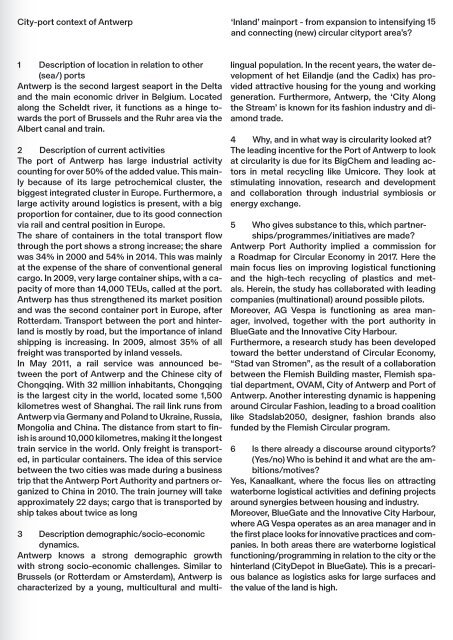Circular City Ports - Workbook
Create successful ePaper yourself
Turn your PDF publications into a flip-book with our unique Google optimized e-Paper software.
<strong>City</strong>-port context of Antwerp<br />
‘Inland’ mainport - from expansion to intensifying<br />
and connecting (new) circular cityport area’s?<br />
15<br />
1 Description of location in relation to other<br />
(sea/) ports<br />
Antwerp is the second largest seaport in the Delta<br />
and the main economic driver in Belgium. Located<br />
along the Scheldt river, it functions as a hinge towards<br />
the port of Brussels and the Ruhr area via the<br />
Albert canal and train.<br />
2 Description of current activities<br />
The port of Antwerp has large industrial activity<br />
counting for over 50% of the added value. This mainly<br />
because of its large petrochemical cluster, the<br />
biggest integrated cluster in Europe. Furthermore, a<br />
large activity around logistics is present, with a big<br />
proportion for container, due to its good connection<br />
via rail and central position in Europe.<br />
The share of containers in the total transport flow<br />
through the port shows a strong increase; the share<br />
was 34% in 2000 and 54% in 2014. This was mainly<br />
at the expense of the share of conventional general<br />
cargo. In 2009, very large container ships, with a capacity<br />
of more than 14,000 TEUs, called at the port.<br />
Antwerp has thus strengthened its market position<br />
and was the second container port in Europe, after<br />
Rotterdam. Transport between the port and hinterland<br />
is mostly by road, but the importance of inland<br />
shipping is increasing. In 2009, almost 35% of all<br />
freight was transported by inland vessels.<br />
In May 2011, a rail service was announced between<br />
the port of Antwerp and the Chinese city of<br />
Chongqing. With 32 million inhabitants, Chongqing<br />
is the largest city in the world, located some 1,500<br />
kilometres west of Shanghai. The rail link runs from<br />
Antwerp via Germany and Poland to Ukraine, Russia,<br />
Mongolia and China. The distance from start to finish<br />
is around 10,000 kilometres, making it the longest<br />
train service in the world. Only freight is transported,<br />
in particular containers. The idea of this service<br />
between the two cities was made during a business<br />
trip that the Antwerp Port Authority and partners organized<br />
to China in 2010. The train journey will take<br />
approximately 22 days; cargo that is transported by<br />
ship takes about twice as long<br />
3 Description demographic/socio-economic<br />
dynamics.<br />
Antwerp knows a strong demographic growth<br />
with strong socio-economic challenges. Similar to<br />
Brussels (or Rotterdam or Amsterdam), Antwerp is<br />
characterized by a young, multicultural and multi-<br />
lingual population. In the recent years, the water development<br />
of het Eilandje (and the Cadix) has provided<br />
attractive housing for the young and working<br />
generation. Furthermore, Antwerp, the ‘<strong>City</strong> Along<br />
the Stream’ is known for its fashion industry and diamond<br />
trade.<br />
4 Why, and in what way is circularity looked at?<br />
The leading incentive for the Port of Antwerp to look<br />
at circularity is due for its BigChem and leading actors<br />
in metal recycling like Umicore. They look at<br />
stimulating innovation, research and development<br />
and collaboration through industrial symbiosis or<br />
energy exchange.<br />
5 Who gives substance to this, which partnerships/programmes/initiatives<br />
are made?<br />
Antwerp Port Authority implied a commission for<br />
a Roadmap for <strong>Circular</strong> Economy in 2017. Here the<br />
main focus lies on improving logistical functioning<br />
and the high-tech recycling of plastics and metals.<br />
Herein, the study has collaborated with leading<br />
companies (multinational) around possible pilots.<br />
Moreover, AG Vespa is functioning as area manager,<br />
involved, together with the port authority in<br />
BlueGate and the Innovative <strong>City</strong> Harbour.<br />
Furthermore, a research study has been developed<br />
toward the better understand of <strong>Circular</strong> Economy,<br />
“Stad van Stromen”, as the result of a collaboration<br />
between the Flemish Building master, Flemish spatial<br />
department, OVAM, <strong>City</strong> of Antwerp and Port of<br />
Antwerp. Another interesting dynamic is happening<br />
around <strong>Circular</strong> Fashion, leading to a broad coalition<br />
like Stadslab2050, designer, fashion brands also<br />
funded by the Flemish <strong>Circular</strong> program.<br />
6 Is there already a discourse around cityports?<br />
(Yes/no) Who is behind it and what are the ambitions/motives?<br />
Yes, Kanaalkant, where the focus lies on attracting<br />
waterborne logistical activities and defining projects<br />
around synergies between housing and industry.<br />
Moreover, BlueGate and the Innovative <strong>City</strong> Harbour,<br />
where AG Vespa operates as an area manager and in<br />
the first place looks for innovative practices and companies.<br />
In both areas there are waterborne logistical<br />
functioning/programming in relation to the city or the<br />
hinterland (<strong>City</strong>Depot in BlueGate). This is a precarious<br />
balance as logistics asks for large surfaces and<br />
the value of the land is high.


















